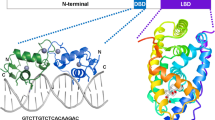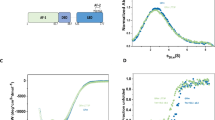Abstract
Sequence-specific interaction between steroid hormone receptors (R) and DNA hormone-responsive elements (HRE) takes place in vitro irrespective of the presence of hormone and even when R is liganded with an antagonist1,2. In vivo, in contrast, the presence of hormone is mandatory for glucocorticosteroid (G) receptor-HRE interaction to occur and no HRE occupancy is detected in the presence of an antagonist3. One possible explanation is that in vivo R is originally complexed with a protein that prevents its binding to target HREs. The hormone would then induce the dissociation of the oligomer, thus unmasking the functional DNA binding domain of the receptor. The unliganded, non DNA-binding 8S-f orm of the chick GR is a hetero-oligomer including the relative molecular mass (Mr) 94,000 steroid-binding unit (4S-GR), and the non-steroid-binding, non-DNA-binding 90,000 protein4 common to all classes of 8S-R5 and identified as heat-shock protein (hsp90)6–8. We report here that triamcinolone acetonide (TA) promotes the transformation of 8S-GR to 4S-GR complexes both in explants and in cell-free conditions and that the high-affinity antiglucocorticosteroid RU 4869 stabilizes the 8S-GR, as assessed by gradient sedimentation and HPLC. However, in vitro TA- and RU 486- 4S-GR showed comparable DNA-binding activity. These results suggest that the lack of affinity for DNA of the 8S form of GR may be attributable in vivo to the interaction of the 4S-GR protein with hsp 90, and that hormone binding might trigger a conformational change which results in the release of active 4S-GR.
This is a preview of subscription content, access via your institution
Access options
Subscribe to this journal
Receive 51 print issues and online access
$199.00 per year
only $3.90 per issue
Buy this article
- Purchase on Springer Link
- Instant access to full article PDF
Prices may be subject to local taxes which are calculated during checkout
Similar content being viewed by others
Author information
Authors and Affiliations
Rights and permissions
About this article
Cite this article
Groyer, A., Schweizer-Groyer, G., Cadepond, F. et al. Antiglucocorticosteroid effects suggest why steroid hormone is required for receptors to bind DNA in vivo but not in vitro. Nature 328, 624–626 (1987). https://doi.org/10.1038/328624a0
Received:
Accepted:
Issue Date:
DOI: https://doi.org/10.1038/328624a0
This article is cited by
-
Interleukin-6 and Glucocorticoids Synergistically Induce Human Immunodeficiency Virus Type-1 Expression in Chronically Infected U1 Cells by a Long Terminal Repeat Independent Post-Transcriptional Mechanism
Molecular Medicine (2001)
-
Cellular and molecular aspects of the renal effects of diuretic agents
Kidney International (1990)
Comments
By submitting a comment you agree to abide by our Terms and Community Guidelines. If you find something abusive or that does not comply with our terms or guidelines please flag it as inappropriate.



